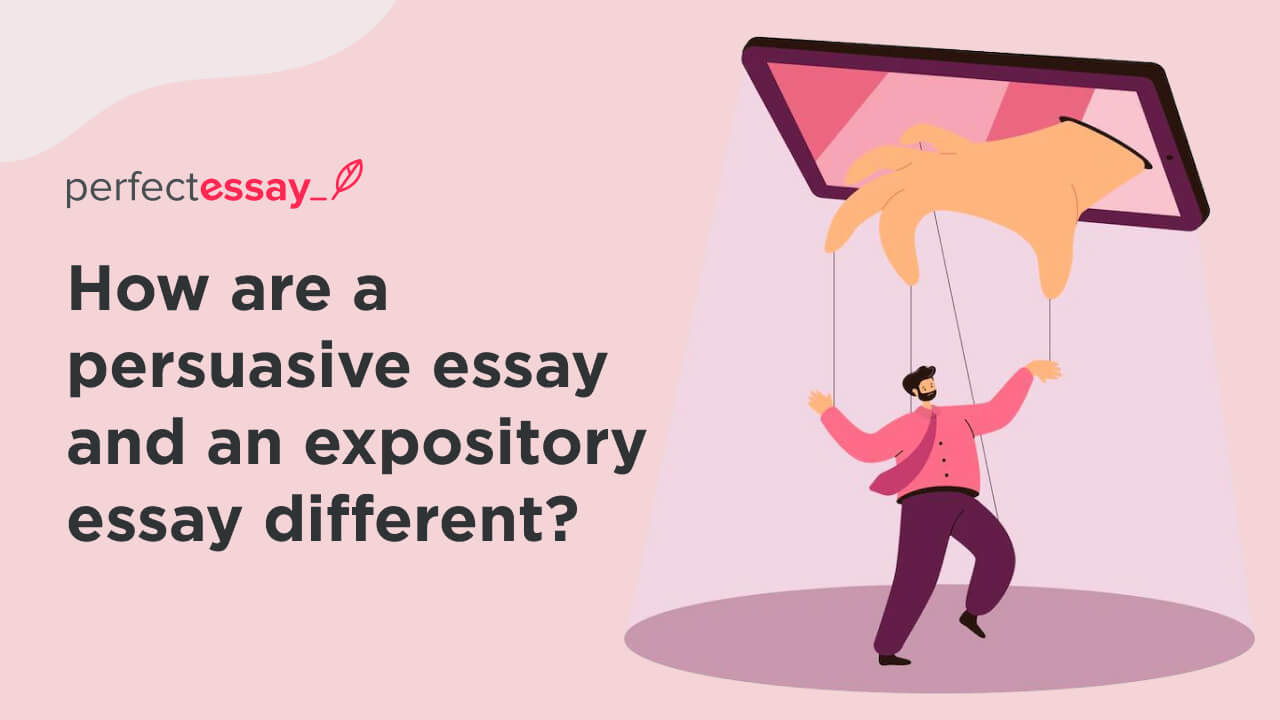Table of Contents
Understanding The Differences Before Writing
When teachers assign essays to students, they must understand the differences between different types of essays. These essays indeed share many characteristics, but certain exclusive things make them what they are.
Understanding the differences before writing can help students set up a specific course and pace for their essays. Otherwise, they will have to go through various rounds of course correction and editing before they can even complete the first draft.
What Is A Persuasive Essay?
A persuasive essay, as the name suggests, is at the heart of convincing and influencing readers. A simple but comprehensive definition of a persuasive essay is that it is the kind of essay where a writer uses logic and reasoning to convince readers of his point of view.
The subject or point to which he needs to persuade the readers can vary, from political to economic to social and sociological issues. The language of this is often objective but writers can employ signature prose to add further dramatic elements to their writing.
One thing that differentiates a persuasive essay from an expository essay is that writers can express their opinions and comment on issues. But this is not it. They need to provide evidence to prove that their findings are well-grounded.
Reliance On Reasoning And Logic
Narrative essays rely on the power of story-telling; descriptive essays rely on figurative language and sensory details. Compared to these, a persuasive essay relies on reasoning and logic. It means that writers can make a stance based on their personal experience and biases, but they need to provide empirical evidence through references from credible sources, quotes from experts, and so on.
Persuasive essays are also called argumentative essays because the writer put forward an argument and then provides supporting materials to further strengthen it. This is another thing that sets them apart from expository essays where writers can only provide actionable information in objective language and unbiased tone and voice.
Steps In Writing A Persuasive Essay
A persuasive essay is composed of both impassioned arguments and personal opinions. What sets it apart from a truly subjective piece of writing is its reliance on reasoning and logic to get to the readers. It is perhaps one of the many types of essays where readers and their level of understanding matter even before getting started.
This section will cover the process of writing a quality persuasive essay.
Understanding Readers’ Persona
Just like writing for a brand or any audience to convince them about a product or service, a persuasive essay writer needs to understand his readers’ persona before getting started. In schools and colleges, the readers are instructors and professors with extensive knowledge and experience who will evaluate the essays. This automatically raises the bar for everyone because they need to produce the finest work.
Highlighting Your Stance Early On
Also called an argumentative essay, writers should clear their position regarding an argument early on. It means there is no need to mince words or start with a long shot. Writers should get to the brass tacks from the introduction and clear their position to the readers. This will help them in understanding the whole essay. All sections should be written with the intent to convince readers.
Drawing A Roadmap – From Start To Finish
Like outlining, a roadmap identifies the major milestones in the journey before a writer reaches them. This starts with research and collecting necessary information and then connects with the main arguments and opinions of the essay. It is best to outline as extensively as possible because it will keep the direction true and make sure there are no bottlenecks in the process of writing.
Supporting Arguments And Opinions With Evidence
This is common between expository and persuasive essays in that they are both grounded in evidence and proof. Since the whole text of expository essays is baked in objective views and impersonal statements, the contents of persuasive essays can be passionate and personal. But they need anchors in the form of evidence and references from credible sources. Otherwise, the whole essay will fall flat and could not get to the readers.
What Is An Expository Essay?
An expository essay is a type of essay where writers provide factual information to the readers through arguments and evidence. Compared to narrative and descriptive essays, expository essays are considered complicated because writers cannot rely on memory and personal narrative.
An expository essay is similar to manuals and how-to articles where readers receive actionable knowledge to reach a predictable conclusion. There are different types of expository essays that writers can employ to get their points across. These include definition essays, classification essays, compare and contrast essays, as well as cause and effect essays.
The structure and formatting of an expository essay are similar to conventional essays, with three major sections covering all the bases.
Conveying Factual Information Objectively
Writers need to provide factual information to the readers through expository essays. The introduction starts with a logical hook to lure the readers in. Then, comes the main body where writers can put forward postulates and support them with empirical evidence and proofs.
One of the major mistakes that students make while writing an expository essay is to add personal opinions and commentary to the text. This is admissible in a persuasive essay but not in an expository one. Also, a subjective language with sensory experience or figurative language is not suitable for expository essays.
It should be just facts, backed by credible sources to help readers reach a predictable conclusion.
Steps In Writing An Expository Essay
Research and outline is the first step in writing an expository essay. There is no way they can wing it and make it up as they go. The best way to cover these is by researching and outlining at the same time. This will determine the heading, depth, and scope of the topic for the writers. This is necessary for persuasive essays also, but it is a must-have for expository essays.
A hook is a statement that can attract readers and grab their attention toward the essay. It is introduced at the very beginning of the essay. It can be a statement with bold claims or shocking facts, a question to the readers, or a statistic that can provide context to the topic or thesis of the essay. Since the introduction is the most important section of the essay, this should be composed with great care.
A thesis statement is the compact form of the theme and main idea of the topic. All the sections and elements of an essay exist to justify the existence of the thesis statement. Mostly, it is a single bold and brief statement, but exceptions can be made, depending on the word count and scope of the essay. No matter the length of the thesis statement, it should come at the end of the introduction.
This makes the bulk of the expository essays because this is where all the magic happens. The introduction provides context and hooks to this, whereas a conclusion summarizes the main points discussed in this section. Writers should aim for objective and unbiased information free from any commentary or speculation. Each paragraph should be allotted to a single argument with supporting evidence and proof. This will help readers to follow the information through.
The conclusion is often the last part that readers go through in the essay. It is also the section that can make the difference for them in terms of keeping the details. The purpose of writing a conclusion is to summarize the main ideas from the body of the essay and reproduce them in a compact form. This does not mean that conclusion does not add any value to the essay. It does, but it is subtle.
After completing the first draft, it is best to let the manuscript be and come back to it with fresh eyes and perspective. The best way to proofread and edit the draft is by dividing the main items, including grammar, punctuation, syntax, context, etc. Students can also take advantage of online tools such as Grammarly and Hemingway Editor to tighten their prose. The end product should reflect the best quality in expository essay writing.
F.A.Q
Can I provide my opinion in a persuasive essay?
Yes, you can. A persuasive essay is about giving your opinion and then persuading the readers through evidence, proof, and so on. On the other hand, expository essays are about providing factual information to the readers with no room for suggestions and comments.
Is there any room for emotions and sentimentality in expository essays?
Expository essays are about conveying factual information to the readers in objective language with an unbiased tone and voice. There is no room for sentimentality and subjectivity in expository essays.
What are the major sections in persuasive and expository essays?
The following are three main sections that are common in both expository and persuasive essays:
- Introduction/ opening
- Main body
- Conclusion/ Closing
How can I make the word count for college essays?
College essays have a set word count. In most cases, it is around 1250 to 1500 words. For students who struggle with making the word count, it is best to take a look at the essay and expand the ideas and arguments that are central to the premise. This way, it will not only make the word count but strengthen the narrative.
Why is it necessary to research before writing a persuasive or expository essay?
When it comes to writing expository and persuasive essays, it is necessary to go through the research and collect all the necessary information. This will help writers compose their arguments around empirical evidence. Since there is no place for personal opinions in expository essays, writers should go through this phase before moving forward.
What is the importance of editing and proofreading in essay writing?
Editing and proofreading are important parts of essay writing. First drafts, no matter how much care and attention has gone under them, have inconsistencies and errors. That’s why writers should set time to go through the proofreading and editing phase before submitting the essay.
Writing Exceptional Essays For Exceptional Scores
In schools and colleges, students’ research and writing skills are gauged through expository and persuasive essay writing. Whether it is about understanding the mechanics of essay writing or learning about the differences between various essay types, students must go through them as soon as possible.
This blog post was dedicated to knowing what are expository and persuasive essays, how they are both written, through which we have learned about their key differences.
We hope that students will find this resource helpful in understanding the nature of their assignments before sitting down to write. This will help them save time and effort.
Free Features For You




